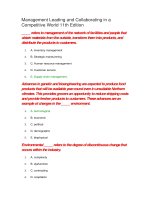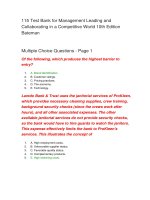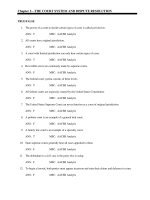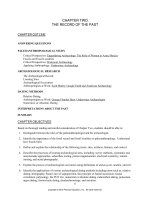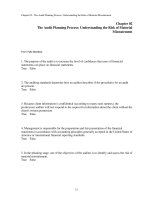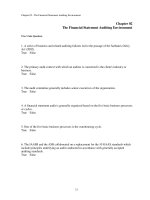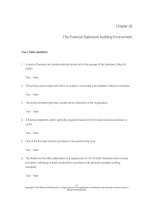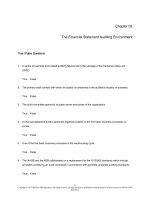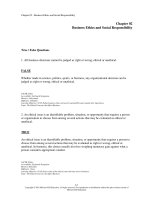International business competing and cooperating in a global world 1st edition geringer test bank
Bạn đang xem bản rút gọn của tài liệu. Xem và tải ngay bản đầy đủ của tài liệu tại đây (598.04 KB, 140 trang )
Module 02 International Trade and Investment
True / False Questions
1.
Record levels of American outward foreign direct investment from 2010 to 2013, totaling more
than $1.4 trillion, caused U.S. exports to decline during this time period.
True
2.
International trade includes exports, imports, and foreign direct investment.
True
3.
False
Nearly 60 percent of global output is now destined for international trade.
True
4.
False
False
The proportion of world trade coming from Latin America, Africa, and the Middle East has
decreased since 1980.
True
5.
False
All regions of the world experienced an absolute increase in the dollar volume of their services
exports since 1980, although the U.S. proportion has risen by approximately one-third since that
time.
True
6.
False
In 2013, the top 10 exporting and importing nations collectively accounted for over half of all
exports and imports of merchandise and services worldwide.
True
False
2-1
Copyright © 2016 McGraw-Hill Education. All rights reserved. No reproduction or distribution without the prior written consent of
McGraw-Hill Education.
7.
Approximately two-thirds of the exports from developed countries go to developed countries.
True
8.
False
The development of expanded regional trade agreements, such as the Association of Southeast
Asian Nations, Mercosur, and the EU, can substantially alter the level and proportion of trade flows
within and across regions.
True
9.
False
There are a number of advantages in focusing attention on a nation that is already a sizable
purchaser of goods coming from the would-be exporter's country.
True
False
10. The first formulation of international trade theory, by Adam Smith, was motivated by political
considerations.
True
False
11. The central idea of mercantilism is there should be an export surplus so a nation can accumulate
precious metals.
True
False
12. The theory of absolute advantage suggests that under free, unregulated trade, each nation should
specialize in producing those goods it can produce most efficiently, based on naturally occurring
endowments such as minerals.
True
False
13. According to the theory of comparative advantage, a nation can gain from trade if it is not equally
less efficient in producing two goods.
True
False
2-2
Copyright © 2016 McGraw-Hill Education. All rights reserved. No reproduction or distribution without the prior written consent of
McGraw-Hill Education.
14. If a Chinese worker earns $1.00 a day, then goods produced by this worker will cost less than the
same goods produced by an American earning $18.00 an hour.
True
False
15. Currency devaluation helps a nation avoid losing markets and regain competitiveness in world
markets.
True
False
16. A theory developed by Eli Heckscher and Bertil Ohlin at the Stockholm School of Economics
suggests that differences in resource endowments will make developed countries more likely to
trade with developed countries whose resource endowments are likely to be very similar, than with
developing countries whose endowments are dissimilar.
True
False
17. According to the text, differences in taste, a demand variable, can reverse the direction of trade
predicted by the theory.
True
False
18. The international product life-cycle theory may have its greatest usefulness in explaining trade and
investment behavior when international firms introduce their new products in home markets first.
True
False
19. The predictable decline in the average cost of producing each unit of output as a production
facility gets larger and output increases is known as the experience curve.
True
False
20. Michael Porter claims that demand conditions, factor conditions, related and supporting industries,
and firm strategy, structure, and rivalry, rather than government and chance, are factors that affect
national competitiveness.
True
False
2-3
Copyright © 2016 McGraw-Hill Education. All rights reserved. No reproduction or distribution without the prior written consent of
McGraw-Hill Education.
21. Importing and foreign direct investment are two approaches to meeting overseas demand.
True
False
22. Portfolio investment is the purchase of sufficient stock in a firm to obtain significant management
control.
True
False
23. The proportion of the outstanding stock of foreign direct investment accounted for by the United
States declined by two-thirds over the past 20 years.
True
False
24. The overall volume of outward FDI from developing nations in 2013 was four times the level in
2003.
True
False
25. The vast proportion of outward FDI, about two-thirds, originates from the developed countries.
True
False
26. Worldwide, the volume of FDI flowing into the developing countries as a whole was seven times
larger in 2000 than in 1990 and had nearly tripled again by 2013.
True
False
27. Foreign direct investment may be an attempt by foreign companies to establish competitive
advantage over potential competitors in other markets, due to possession of advantages not
available to local firms. Such advantages possessed by foreign companies over their local
competitors include knowledge about local market conditions and cost efficiencies from operating
at a distance.
True
False
2-4
Copyright © 2016 McGraw-Hill Education. All rights reserved. No reproduction or distribution without the prior written consent of
McGraw-Hill Education.
28. Internalization theory suggests that what an organization is good at should not be outsourced
without very careful consideration.
True
False
29. The dynamic capability theory states that for a firm to invest overseas, it must have three kinds of
advantages: ownership specific, internalization, and location specific.
True
False
30. Dunning's Eclectic Theory of International Production provides an explanation for the choice by
the international firm of its overseas production facilities.
True
False
Multiple Choice Questions
31. Foreign direct investment (FDI) from the United States to the rest of the world reached a record
high of $1.4 trillion from 2010 to 2013. This volume of FDI was _________ the U.S. average a decade
before.
A. one and a half times
B. double
C. almost three times
D. five times
E. more than nine times
2-5
Copyright © 2016 McGraw-Hill Education. All rights reserved. No reproduction or distribution without the prior written consent of
McGraw-Hill Education.
32. According to the Exporter Data Base, small and medium-sized enterprises accounted for
___________ of all U.S. exporters.
A. under 10 percent
B. 25 percent
C. nearly half
D. 86 percent
E. nearly 98 percent
33. Regarding the volume of international trade, exports of U.S. goods and services ___________ in
2014.
A. were nearly $1.0 trillion
B. reached $1.6 trillion
C. were $2.3 trillion
D. were nearly $5.0 trillion
E. exceeded $24.5 trillion
34. The level of merchandise exports in 2013, worldwide, was
A. $4.6 trillion.
B. $8.5 trillion.
C. $12.3 trillion.
D. $18.8 trillion.
E. $23.4 trillion.
2-6
Copyright © 2016 McGraw-Hill Education. All rights reserved. No reproduction or distribution without the prior written consent of
McGraw-Hill Education.
35. The level of services exports in 2013, worldwide, was
A. $4.6 trillion.
B. $8.5 trillion.
C. $12.3 trillion.
D. $18.8 trillion.
E. $23.4 trillion.
36. In examining the volume of international trade
A. exports of goods and services quadrupled between 1990 and 2013.
B. exports of services grew faster than trade in merchandise for the last 20 years.
C. the proportion of world exports of commercial services accounted for by the U.S. fell by nearly
20 percent since 1980.
D. the proportion of world exports of commercial services accounted for by Asian nations
increased by nearly 20 percent since 1980.
E. the proportion of world exports of commercial services accounted for by Latin American nations
increased by nearly 20 percent since 1980.
37. One measure of the magnitude of international trade and how it has grown is _____________ of
global output that is now destined for international trade.
A. 10 percent
B. 25 percent
C. almost 50 percent
D. 60 percent
E. 75 percent
2-7
Copyright © 2016 McGraw-Hill Education. All rights reserved. No reproduction or distribution without the prior written consent of
McGraw-Hill Education.
38. The proportion of world trade accounted for by North America has evidenced ____ since 1980.
A. an increase of 20 percent
B. a tripling
C. an overall decline
D. more than a fivefold increase
E. no change
39. The proportion of world trade accounted for by Latin America has evidenced ____ since 1980.
A. an increase of 20 percent
B. a tripling
C. an overall decline
D. more than a fivefold increase
E. no change
40. The proportion of world trade accounted for by Asia has ____ since 1980.
A. increased by 20 percent
B. tripled
C. seen an overall decline
D. almost doubled
E. increased fivefold
41. The proportion of world trade in services accounted for by North America has evidenced ____ since
1980.
A. an increase of 20 percent
B. a tripling
C. an overall decline
D. more than a fivefold increase
E. an increase of one-third
2-8
Copyright © 2016 McGraw-Hill Education. All rights reserved. No reproduction or distribution without the prior written consent of
McGraw-Hill Education.
42. The proportion of world trade in services accounted for by the European Union has evidenced ____
since 1980.
A. an increase of 20 percent
B. a tripling
C. an overall decline
D. more than a fivefold increase
E. an increase of one-third
43. The rapid expansion of world exports since 1980 demonstrates that
A. businesspeople can expect to meet lower levels of competition in their domestic markets.
B. domestic business cannot compete with cheap imports.
C. the opportunity to increase sales by exporting is a viable growth strategy.
D. jobs will inevitably decline in developed countries due to import competition.
E. companies that do not export will probably not survive.
44. In examining the volume of international trade, the proportion of world exports and imports
accounted for by the 10 largest exporting and importing nations in 2013
A. exceeded 70 percent.
B. was approximately 25 percent.
C. exceeded 50 percent.
D. was approximately one-third.
E. was 40 percent.
2-9
Copyright © 2016 McGraw-Hill Education. All rights reserved. No reproduction or distribution without the prior written consent of
McGraw-Hill Education.
45. In examining which nations are responsible for the large and growing levels of merchandise and
services trade that we have seen worldwide
A. the 10 largest exporters and importers are all from developed countries.
B. China ranks as the largest in levels of both merchandise and services exports.
C. the U.S. ranks as the largest in levels of both merchandise and services imports.
D. the European Union ranks as the largest country for merchandise exports.
E. China ranks first or second in each of merchandise and services exports and imports.
46. More than one-half of the exports from developing countries go to __________ countries, and this
proportion has been _____________.
A. developed; increasing
B. developing; increasing
C. developed; decreasing
D. developing; decreasing
E. developing; stable over time
47. Regarding the direction of world trade
A. the proportion of exports going from developing nations to developed nations has been
increasing over the past 35 years.
B. approximately 75 percent of exports from developed economies go to other industrialized
nations.
C. approximately 70 percent of exports from developing countries go to developed nations.
D. more than half of the exports from developing nations go to developed nations.
E. more than half of the exports from developing nations go to other developing nations.
2-10
Copyright © 2016 McGraw-Hill Education. All rights reserved. No reproduction or distribution without the prior written consent of
McGraw-Hill Education.
48. Regarding the direction of world trade
A. approximately three-quarters of the exports from North American nations went to other nations
in North America in 2014.
B. approximately 25 percent of exports from Asian nations went to other Asian nations in 2014.
C. approximately 70 percent of exports from European countries went to other European countries
in 2014.
D. nearly 20 percent of U.S. exports went to Canada in 2014.
E. nearly half of all world trade occurred within regional trade agreements in 2014.
49. When considering where to export, advantages to managers of focusing on a nation that is
already a sizable purchaser of goods coming from the home country include the fact that
A. the cultures of the two countries should be relatively similar and compatible.
B. the climate for foreign direct investment in the importing nation is relatively favorable.
C. export and import regulations are not insurmountable.
D. the two countries are part of the same regional trade agreement.
E. the countries have similar levels of economic development.
50. When considering where to export, advantages to managers of focusing on a nation that is
already a sizable purchaser of goods coming from the home country include the fact that
A. the political climate in the importing nation is relatively stable.
B. there are abundant natural resources in the importing nation.
C. satisfactory transportation facilities have already been established.
D. the trading partner has lower labor costs.
E. both countries are economically prosperous.
2-11
Copyright © 2016 McGraw-Hill Education. All rights reserved. No reproduction or distribution without the prior written consent of
McGraw-Hill Education.
51. When considering where to export, advantages to managers of focusing on a nation that is
already a sizable purchaser of goods coming from the home country include all of the following
except
A. the business climate in these importing nations is already relatively favorable.
B. there are abundant natural resources in the importing nation.
C. satisfactory transportation facilities have already been established.
D. export and import regulations are not insurmountable.
E. currency from the foreign country is available to pay for the exports.
52. When considering where to export, advantages to managers of focusing on a nation that is
already a sizable purchaser of goods coming from the home country include all of the following
except
A. the business climate in these importing nations is already relatively favorable.
B. import channel members (merchants, banks, and customs brokers) are experienced in handling
import shipments from the exporter's area.
C. satisfactory transportation facilities have already been established.
D. export and import regulations are not insurmountable.
E. the cultures of the two countries should be relatively similar and compatible.
53. Regarding the major trading partners of the United States
A. the top 10 accounted for nearly 50 percent of total U.S. goods exports.
B. the top 10 accounted for nearly 50 percent of total U.S. goods imports.
C. China was the largest recipient of U.S. goods exports.
D. China, Canada, and Japan were the three largest sources of U.S. goods imports.
E. China, Canada, and Mexico were the three largest markets for U.S. goods exports.
2-12
Copyright © 2016 McGraw-Hill Education. All rights reserved. No reproduction or distribution without the prior written consent of
McGraw-Hill Education.
54. In 2013, the United States exported the most goods to _______, and imported the most goods from
_______.
A. Canada; Mexico
B. China; Canada
C. Mexico; China
D. Canada; China
E. Germany; China
55. The three largest markets for American exports of goods in 2013 were
A. Japan, the UK, and China.
B. Japan, Mexico, and the UK.
C. Canada, Mexico, and China.
D. Canada, Japan, and the UK.
E. Japan, Mexico, and China.
56. The three nations that exported the largest amount of goods to the United States in 2013 were
A. China, Canada, and Japan.
B. China, Mexico, and the UK.
C. China, Japan, and Saudi Arabia.
D. Canada, Mexico, and Japan.
E. China, Canada, and Mexico.
2-13
Copyright © 2016 McGraw-Hill Education. All rights reserved. No reproduction or distribution without the prior written consent of
McGraw-Hill Education.
57. According to the text, the countries accounting for the largest amount of goods exported from the
U.S. were
A. Canada; Mexico.
B. China; Canada.
C. Mexico; China.
D. Canada; China.
E. Germany; China.
58. Many of the same Asian countries that are major exporters to the United States are also significant
importers of American goods because of all of the following reasons except
A. their rising standards of living enable their people to afford more imported products.
B. they are purchasing large amounts of capital goods to further their industrial expansion.
C. they are importing raw materials and components that will be assembled and subsequently be
exported, often to the U.S.
D. they prefer to deal with the U.S. democratic system than the political systems of Europe.
E. their governments have sent buying missions to the United States to look for products to
import.
59. Supporters of mercantilism
A. viewed accumulation of precious metals as an activity essential to a nation's welfare.
B. viewed industrial development as the primary source of a nation's wealth.
C. promoted trade policies that generally benefitted consumers and emerging industrialists.
D. included prominent economists such as Adam Smith.
E. fervently believed in free trade.
2-14
Copyright © 2016 McGraw-Hill Education. All rights reserved. No reproduction or distribution without the prior written consent of
McGraw-Hill Education.
60. Mercantilists believed that
A. merchants should import goods to raise the level of living.
B. governments should lower import duties.
C. a nation should have an export surplus in order to accumulate precious metals.
D. a nation should produce goods for which there is a comparative advantage.
E. governments should promote selective industrialization in order to achieve balanced trade.
61. Which of the following statements is not true?
A. Although the mercantilist era ended in the late 1700s, its arguments live on.
B. Many of the world's managers see China as a present-day "fortress of mercantilism" that raises
barriers to imported goods while giving its own exporters an unfair advantage.
C. Many people see trade as a zero-sum activity, in which one party must lose for another to gain.
We still use the term favorable trade balance to mean a nation exports more goods and services
than it imports.
D. Mercantilism generated benefits for certain economic groups, such as emerging industrialists
and shippers, though at a cost to other groups including consumers.
E. Mercantilists viewed precious metals such as gold and silver as the only source of wealth, and
their accumulation as essential to a nation's welfare.
62. Adam Smith claimed
A. that governments, not market forces, should determine the directions, volume, and composition
of international trade.
B. a nation could trade advantageously if it had a comparative advantage.
C. that market forces, not government controls, should determine direction, volume, and the
composition of international trade.
D. that customers' tastes are affected by income levels.
E. that trade surpluses were beneficial to countries and should be the focus of trade policy.
2-15
Copyright © 2016 McGraw-Hill Education. All rights reserved. No reproduction or distribution without the prior written consent of
McGraw-Hill Education.
63. The capability of one nation to produce more of a good with the same amount of input than
another country is a/an
A. comparative advantage.
B. absolute advantage.
C. mercantilist advantage.
D. trade surplus.
E. example of perfect competition.
64. If Ecuador has an absolute advantage in coffee and Argentina in wheat, then, according to trade
theory
A. Ecuador should focus production on coffee and trade for other goods.
B. Ecuador would do well to produce its own wheat rather than import it from Bolivia.
C. Argentina should focus on producing coffee and trade for wheat.
D. there will be a perfect trade balance between the two countries.
E. the gains in trade by both countries will be equal.
65. A market situation in which there is a sufficiently large number of well-informed buyers and sellers
of a homogeneous product such that no individual participant has enough power to determine the
price of the product, resulting in a marketplace that is efficient in production and allocation of
products is known as
A. absolute advantage.
B. comparative advantage.
C. competitive advantage.
D. perfect competition.
E. monopoly.
2-16
Copyright © 2016 McGraw-Hill Education. All rights reserved. No reproduction or distribution without the prior written consent of
McGraw-Hill Education.
66. A country ________ when it decides to use its resources to produce only the product in which it has
an absolute advantage.
A. monopolizes
B. specializes
C. rejects trade
D. globalizes
E. achieves equilibrium
67. A nation having absolute disadvantages in the production of two goods with respect to another
nation has a/an ___________ in the production of the good in which its absolute disadvantage is
less.
A. comparative advantage
B. absolute advantage
C. mercantilist advantage
D. competitive advantage
E. monopolistic advantage
68. According to the theory of comparative advantage
A. a nation should produce the goods for which its absolute disadvantage is less.
B. a nation can gain from trade if it is equally inefficient in producing two goods.
C. a nation must have an absolute advantage in at least one good to gain from trade.
D. a nation should strive to produce trade surpluses to acquire supplies of precious metals.
E. a nation should produce goods that are the most technologically advanced.
2-17
Copyright © 2016 McGraw-Hill Education. All rights reserved. No reproduction or distribution without the prior written consent of
McGraw-Hill Education.
69. Which of the following statements is not true?
A. Some observers have argued that American industry and the American economy as a whole will
be strengthened by sending activities to workers in India or other foreign nations that have
comparative advantages in areas such as labor costs.
B. India, with relatively few resources but a large population, should have a comparative advantage
in the production of goods or services that require large amounts of expensive labor.
C. India may have a comparative advantage over some other developing countries because about
350 million of its people are able to read English, and 100 million of those also understand
spoken English and can communicate in English sentences.
D. The sophistication and skill levels required for jobs outsourced to India are rising rapidly, driven
by the abundance of qualified and low-cost workers in India.
E. An estimated 1.6 million U.S. individual and corporate tax returns are prepared annually in India.
70. According to trade theory
A. traders need to know the exchange rate between their own currency and that of the nation they
are considering trading with, before they can decide whether it is advantageous to import,
export, or buy locally.
B. if a currency's exchange rate strengthens, then its exporters will no longer be able to profitably
export their products.
C. devaluation of a currency will automatically cause a nation's products to be price competitive in
international markets.
D. high-cost labor will automatically cause a country to be uncompetitive in export markets.
E. devaluation of a country's currency will cause domestic prices to decrease.
2-18
Copyright © 2016 McGraw-Hill Education. All rights reserved. No reproduction or distribution without the prior written consent of
McGraw-Hill Education.
71. Theory based on ___________________ states that international and interregional differences in
production costs occur because of differences in the supply of production factors.
A. comparative advantage
B. absolute advantage
C. mercantilist advantage
D. resource endowments
E. exchange rates
72. The theory of resource endowment
A. explains why France sends cosmetics, wine, and clothing to Chile.
B. states that a nation will trade goods that can be produced with the production factor that is
most abundant.
C. explains why an automobile can be made either by hand or by a capital-intensive process.
D. explains why transportation costs may be ignored when calculating the costs of imports.
E. shows how larger countries will have an advantage in trade.
73. The theory of overlapping demand
A. explains how international trade in manufactured goods will be linked to gross national income.
B. states that a nation will trade goods that can be produced with the production factor that is
most abundant.
C. explains why companies will add excess capacity to their production systems.
D. explains the existence of similar preferences and demands among countries with similar income
levels.
E. explains where competitive clusters will occur.
2-19
Copyright © 2016 McGraw-Hill Education. All rights reserved. No reproduction or distribution without the prior written consent of
McGraw-Hill Education.
74. The theory of overlapping demand suggests that
A. international trade in services will be more common between countries with high and low
relative levels of labor costs.
B. countries with similar geography will have similar demand traits.
C. trade wars will usually occur between countries that have similar levels of income.
D. international trade in manufactured goods will be more common between countries with similar
levels of income.
E. if a home country can find a product that is desired in another country, then producing demand
for that product within the home country will result in increased economic growth.
75. The international product life cycle
A. explains how international trade in manufactured goods will be linked to gross national income.
B. states that a nation will trade goods that can be produced with the production factor that is
most abundant.
C. is concerned with the role of innovation in trade patterns.
D. explains why mercantilism failed.
E. requires perfect competition as an assumption underlying successful trade.
76. According to the international product life cycle
A. innovation occurs in the U.S. and then goes to other nations.
B. exporting begins in the second stage.
C. exporting replaces direct investment in the second stage.
D. foreign-produced products compete in export markets in the third stage.
E. foreign producers eliminate U.S. producers through continued product innovation.
2-20
Copyright © 2016 McGraw-Hill Education. All rights reserved. No reproduction or distribution without the prior written consent of
McGraw-Hill Education.
77. The international product life cycle theory
A. may have its greatest usefulness in explaining trade and investment behavior when international
firms introduce their new products in foreign markets first.
B. may have its greatest usefulness in explaining trade and investment behavior when product life
cycles are short.
C. may have its greatest usefulness in explaining the emergence of "born global" companies.
D. may have its greatest usefulness in explaining trade and investment behavior when international
firms first introduce new products in their home markets.
E. may have its greatest usefulness in explaining whether companies will innovate or imitate.
78. Economies of scale and the experience curve
A. explain how international trade in manufactured goods will be linked to gross national income.
B. state that a nation will trade goods that can be produced with the production factor that is most
abundant.
C. explain why many companies will engage in international trade.
D. explain the international life cycles of products.
E. are only relevant for manufacturing industries.
79. Economies of scale
A. refer to the rising scale on which efficiency improves as a result of cumulative experience and
learning.
B. are the predictable decline in the average cost of producing each unit of output as a production
facility gets larger and output increases.
C. are only relevant to manufacturing industries.
D. occur due to the presence of abundance resource endowments within a nation.
E. are difficult to achieve if fixed costs are high.
2-21
Copyright © 2016 McGraw-Hill Education. All rights reserved. No reproduction or distribution without the prior written consent of
McGraw-Hill Education.
80. Experience curve
A. refers to the rising scale on which efficiency improves as a result of cumulative experience and
learning.
B. is the predictable decline in the average cost of producing each unit of output as a production
facility gets larger and output increases.
C. is only relevant to manufacturing industries.
D. occurs only in nations with highly skilled labor forces.
E. is difficult to achieve if fixed costs are high.
81. Which of the following elements is included in Porter's diamond model of national advantage?
A. Competitive conditions
B. Export conditions
C. Social conditions
D. Supply conditions
E. Demand conditions
82. Which of the following elements is included in Porter's diamond model of national advantage?
A. Competitive conditions
B. Export conditions
C. Factor conditions
D. Supply conditions
E. Political conditions
2-22
Copyright © 2016 McGraw-Hill Education. All rights reserved. No reproduction or distribution without the prior written consent of
McGraw-Hill Education.
83. Which of the following elements is not included in Porter's diamond model of national
advantage?
A. Demand conditions
B. Factor conditions
C. Export conditions
D. Government
E. Related and supporting industries
84. Porter's diamond model of national advantage
A. claims that the ability of local firms in a country to use the country's resources to gain a
competitive advantage is based on demand conditions, factor conditions, related and
supporting industries, and firm strategy, structure, and rivalry.
B. links intra industry trade to relative levels of per capita income.
C. is based on anecdotal evidence.
D. explains trade surpluses.
E. is not affected by chance.
85. Regarding foreign investment
A. it can be divided into three components: international trade, portfolio investment, and direct
investment.
B. portfolio investment involves investors who participate in the management of the firm in
addition to receiving a return on their money.
C. deals that result in the foreign investor's obtaining at least 10 percent of the shareholdings are
classified as portfolio investments.
D. it exists only due to the presence of exporting.
E. the distinction between portfolio investments and direct investments has begun to blur.
2-23
Copyright © 2016 McGraw-Hill Education. All rights reserved. No reproduction or distribution without the prior written consent of
McGraw-Hill Education.
86. Which of the following is not true regarding foreign investment?
A. Persons residing outside the United States owned U.S. stocks and bonds other than Treasury
securities with a value of $8.0 trillion at the beginning of 2014.
B. The value of U.S. stocks and bonds other than Treasury securities that were owned by persons
residing outside the United States was 10 times larger in 2014 than in 1994.
C. The value of U.S. stocks and bonds other than Treasury securities that were owned by persons
residing outside the United States was more than double the level in 2014 than in 2004.
D. U.S. investors owned $8.7 billion in foreign securities at the beginning of 2014.
E. The value of foreign securities owned by U.S. investors at the beginning of 2014 was five times
larger than in 2004.
87. At the beginning of 2014, the value of the outstanding stock of foreign direct investment of all
nations totaled more than
A. $3 billion.
B. $8 trillion.
C. $19 trillion.
D. $26 trillion.
E. $42 trillion.
88. Firms from __________ had the largest total outstanding stock of direct overseas investment at the
beginning of 2014.
A. Germany
B. the United States
C. the United Kingdom
D. Japan
E. China
2-24
Copyright © 2016 McGraw-Hill Education. All rights reserved. No reproduction or distribution without the prior written consent of
McGraw-Hill Education.
89. Regarding the value of the outstanding stock of foreign direct investment, which of the following is
not true?
A. During the prior three decades up to 2014, the proportion of FDI accounted for by the
European Union increased.
B. During the prior three decades up to 2014, the proportion of FDI accounted for by the European
Union decreased by over half.
C. Developing countries have dramatically increased their share of FDI stock, from 1 percent in
1980 to 19 percent at the beginning of 2014.
D. The value of the outstanding stock of foreign direct investment of the European Union was
more than 50 percent higher than the level for the United States at the beginning of 2014.
E. The value of the outstanding stock of foreign direct investment of the developing countries was
higher than the level for the United States at the beginning of 2014.
90. Regarding the annual outflows of foreign direct investment, which of the following is not true?
A. The overall volume of outward FDI from developing nations in 2013 was nine times the level in
2003.
B. The proportion of worldwide outward FDI that came from developing nations increased from
under 5 percent in 1990 to over 32 percent in 2013.
C. U.S. FDI outflows of $338 billion in 2013 were more than the combined outflows of the next
three largest sources of FDI: Japan, China, and Saudi Arabia.
D. The United States and the EU combined have continued to account for one-third to one-half of
worldwide FDI in recent years.
E. The United States was the leading single national source of FDI outflows through most of the
period from 1990 to 2013, with an average of nearly one-quarter of total FDI outflows for 20102013.
2-25
Copyright © 2016 McGraw-Hill Education. All rights reserved. No reproduction or distribution without the prior written consent of
McGraw-Hill Education.
